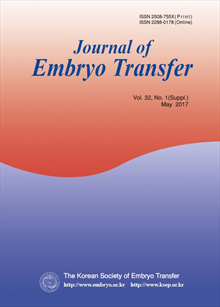간행물
한국동물생명공학회 학술대회논문집

- 발행기관 한국동물생명공학회(구 한국수정란이식학회)
- 자료유형 학술대회
- 간기 반년간
- 수록기간 1997 ~ 2018
- 주제분류 자연과학 > 생물공학 자연과학 분류의 다른 간행물
- 십진분류KDC 527DDC 636
권호리스트/논문검색
2018년도 발생공학 국제심포지엄 (2018년 11월) 122건
Poster Presentation _Embryo Culture
121.
2018.11
구독 인증기관·개인회원 무료
The ovum pick up(OPU) technique can be used to produce embryos after in vitro culture of ovarian oocytes, can be used for early securement for effective herd early proliferation and excellent Hanwoo genetic resources, It is attracting attention as a very important technique for establishing technology. In addition to in vitro culture techniques, the number of oocytes retrieved depends on the environment and timing of the OPU. This study was conducted to compare and examine seasonal effect to the differences in the number of recovered oocytes, recovery rate and embryo development rate using Korean cattle kept in animal genetic resource research center by OPU technique. The grade of COCs was evaluated by microscopic examination. Grade A had 3 or more layers of cumulus cell and compact cytoplasm. Grade B had 1~3 layers of cumulus cell and compact cytoplasm. Grade C had 1 layers cumulus cell and compact cytoplasm. Grade D was denuded oocyte and poor cytoplasm. The recovery rate was 47.8±3.4% in summer (June to August) and 51.6±3.8% in autumn (September to October). The number of oocytes was 5.7±0.6 in summer and 5.2±0.7 in autumn. Oocyte grade A and B was 46.2%±6.3% in summer and 51.1±5.0% in autumn. The cleavage rate was 46.1±7.1% in summer and 65.0±11.3% in autumn. Blastocyst development rate was 19.9±9.4% in summer and 29.0±8.7% in autumn. There was no difference the recovery rate of oocytes and the number of embryos between summer and autumn. Cleavage rate and blastocyst rate of autumn was higher than summer. we will investigate to study the appropriate method for the production of Hanwoo embryos and the systematic comparison.
122.
2018.11
구독 인증기관·개인회원 무료
Jae-Wook Yoon, Min-Jee Park, Chan-Oh Park, Seung-Eun Lee, Eun-Young Kim, Won-Jae Kim, Hyo-Jin Park, Se-Pill Park
The Jeju Black Cattle (JBC) are a type of traditional Korean native cattle with a characteristic black fur that covers the entire body. Semen analysis is the most commonly used procedure to evaluate male fertility potential. This study was to evaluate the quality of 10 JBC bulls belonging to Jeju Special Self-Governing Province Promotion Institute. [JBC A∼J grade]. The freezing medium (20% egg yolk plus 20% triladyl) was added in semen sample to a final concentration of 100×106 sperm/ml. For sperm cooling, diluted semen was filled in 0.5 ml plastic straws and then kept in refrigerator at 4°C for 2 h. They were placed in 7 cm over liquid nitrogen (LN2) vapor for 10 min and then directly plunged into LN2 for storage. Thawing was done by transferring the frozen straws into water bath at 37°C for 30 sec for analysis. The sperm motility, vitality and morphology in each group was assessed using the Sperm Analysis Imaging System (SAIS Plus; Medical Supply Co, Ltd., Korea), eosin-nigrosin stain and diff-quik kit. There was no difference in the motility of the fresh groups (87.4 ~ 100%), while it was difference in the frozen-thawed groups (42.8 ~ 98.6%) (p<0.05). The best motility was shown in JBC-B (100/fresh and 98.6%/frozen-thawed). There was significant difference in the vitality of the fresh group (19.8 ~ 59.2%) and frozen-thawed group (21.2 ~ 49.8%)(p<0.05). The highest vitality was also shown in JBC-B (59.2/fresh and 49.8%/frozen-thawed). Morphologically, in fresh semen the highest normal ratio was indicated in JBC-E (90.9%) and in frozen-thawed group the highest was in JBC-C (90.2%). These results demonstrated that the analysis including motility, vitality and morphology of fresh or frozen-thawed semen is valuable to select the high quality sperm using for reproduction.

